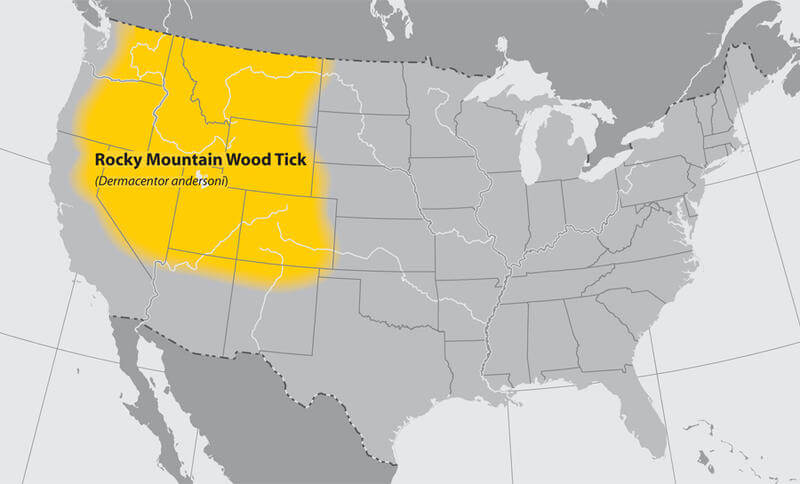Rocky Mountain Wood Ticks
by Tom Schwan
Broadcast 5.5 & 5.8.2020

Range of Rocky Mountain Wood Ticks (photo from the CDC, public domain).
Listen:
Spring has hit western Montana in full force. Days are longer than nights, temperatures are warming, and the snow is gone for the lower elevations. Animals that live here throughout the year, but become quiescent during the long, cold winters, are once again warm, active, and searching for their first meals of the spring. Such an animal is the Rocky Mountain wood tick, one of approximately 825 species of ticks known in the world, which as a group feeds solely on the blood of terrestrial vertebrates.
Their total dependence on blood, and the ability of many species of ticks to feed on humans, makes these very small arthropods both pests and potentially dangerous to us. Infectious agents such as bacteria, viruses, and protozoa may be circulating in the blood of wild mammals when larval and nymphal ticks feed on them. These agents are ingested by the ticks and then may be transmitted later in their saliva when the nymphal and adult ticks feed again on wild mammals or possibly humans. In the United States, Rocky Mountain spotted fever, lyme disease, Colorado tick fever, babesiosis, relapsing fever, and tularemia are some of the diseases that humans may develop after being infected by tick-bite.
Right now in western Montana, ticks are also out in full force as the unfed adult male and female wood ticks have become active after the long winter, thirsty for the blood of large mammals such as deer, elk, moose, and mountain goats. It is important for you to remember that if you go hiking, bird-watching, or camping during the next several weeks, you have a good chance of coming in contact with these ticks that may attempt to feed on you.
In the Bitterroot Valley one to five percent of these ticks are infected with the bacterium that causes Rocky Mountain spotted fever, a potentially fatal disease of humans but treatable with antibiotics if diagnosed early. Therefore, it is also important for you to check yourself frequently when you’re in the woods and remove any ticks that you may have acquired from the surrounding vegetation. Simply flick the ticks off with a finger. If a tick has attached to your skin and begun to feed, remove it with tweezers as quickly as possible. Remember that the longer a tick feeds, the greater the chances that it will transmit a disease-causing agent to you if the tick is infected.
Although a tick is not an insect (an insect has six legs, adult ticks have eight), insect repellents that you use for mosquitoes or black flies may also help to repel ticks. Tucking your pant legs into your socks, and tucking your shirt into your pants, will also help prevent ticks from having easy access to your skin when they are walking on your clothing.
So don’t be afraid of ticks. They are actually fascinating animals, beautifully adapted to their own way of life. But be aware of them, especially right now, and when you are out enjoying this beautiful spring weather, don’t let the ticks feed on you.
In 2019, scientists at Rocky Mountain Labs in Hamilton, Montana, published the results of a study of the prevalence of the Colorado tick fever virus on ticks in the Bitterroot Valley. Their findings: 6.6% of the ticks they analyzed carried the CTF virus.
Every week since 1991, Field Notes has inquired about Montana’s natural history. Field Notes are written by naturalists, students, and listeners about the puzzle-tree bark, eagle talons, woolly aphids, and giant puffballs of Western, Central and Southwestern Montana and aired weekly on Montana Public Radio.
Click here to read and listen to more Field Notes. Field Notes is available as a podcast! Subscribe on iTunes, Google Play, or wherever you listen to podcasts.
Interested in writing a Field Note? Contact Allison De Jong, Field Notes editor, at adejong [at] montananaturalist [dot] org or 406.327.0405.
Want to learn more about our programs as well as fun natural history facts and seasonal phenology? Sign up for our e-newsletter! You can also become a member and get discounts on our programs as well as free reciprocal admission to 300+ science centers in North America!












